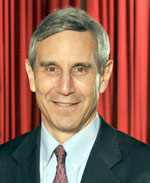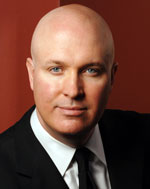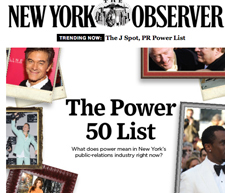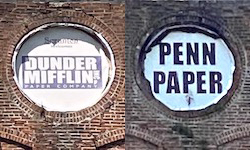The New York Observer, which has a weekly circulation of 51,000 to a well-heeled audience, has a front page story plus four inside pages on New York PR firms in its Oct. 14 issue.
 Edelman
|
"The Power 50 List" sketches 50 PR firms topped by Edelman, which had $707 million in net fees for the year ended June 30. This is a jump from the $655.9M in fees for the year to Dec. 31, 2012.
No. 2 in the 2012 O'Dwyer ranking was APCO Worldwide, based in Washington, D.C., which had fees of $121.8M.
Michael Kaminer, who had his own PR firm for many years and who has become a fulltime journalist, is author of the sweeping article which is a welcome addition to coverage of the PR industry.
It puts to shame the New York Times which confines its coverage of PR to occasional columns by Stuart Elliott.
Kaminer's "Power 50 List" includes 17 firms that are ranked by O'Dwyer's. Such firms provide top pages of corporate income tax returns; W-3s showing payroll totals; CPA attestation to full time employees, and account and staff lists.
Traditional Media, New York Are Plugged
The article is not only a send-up of New York, but of traditional media.
 Cassidy
|
"The major media companies, who are reinventing themselves to be on digital platforms, are not going anywhere, in fact they are only going to get bigger," said Sean Cassidy, president of DKC, which is given second position below Edelman on Kaminer's "Top 50."
DKC, with $32.8M in 2012 fees, +22%, is No. 9 in the O'Dwyer rankings and in third position in the New York rankings below Edelman and Ruder Finn.
Steven Hall, president of The Hall Co., which has offices in New York and Los Angeles, told Kaminer that New York continues to be the center of the communications universe.
"We still have more local outlets than any other market and the majority of national publications have offices here," he said.
"We have the Times, the Post, the News, the Observer. There's a huge amount of opportunity compared to most places. And the direct link to journalists is much stronger here. Bloggers haven't diminished that."
Stu Loeser of Stu Loeser & Co. (No. 27 on Kaminer's list) said that outside of a few star reporters, "nothing takes off in a way that even a small story in the New York press does. That theory about Twitter just didn't pan out."
Finn Partners, Rubenstein PR, W20 Are Missed
The other 33 firms are of varying sizes and include eight PR operations whose conglomerate owners won't let them publish payroll totals and staff counts although no legal, SEC rules or accounting standards prevent that.
The 25 others named include firms claiming substantial fees and staff counts but who have yet to put up proof of this.
Not present on the list but should have been were three sizable New York operations, W2O Group with $30.7M in 2012 fees and 140 staff in New York; Finn Partners, with New York fees of $17.1M and 134 staff, and, Rubenstein PR, 35 staff, headed by Richard Rubenstein, son of Howard Rubenstein of Rubenstein Assocs., which is No. 3 on Kaminer's list.
 Kaminer |
42West, entertainment specialist that grew from the Dart Group in 2006, claims $20M in New York fees and 50 employees; Shift Communications, $15M in New York fees and 13 employees; Paul Wilmot Communications, $10M and 42 employees; LaForce + Stevens $14M and 90 employees; Alison Brod PR, 60 employees; M Booth, $14.6M and 90 employees, and Bullfrog & Baum, $5M and 22 employees.
Outstanding specialists are said to include Stu Loeser & Co., headed by Stu Loeser who spent six years as Mayor Bloomberg's chief spokesperson; Boneau Bryan-Brown, a
"superstar among the sea of theater PR firms," and KCD, headed by Julie Mannion and Ed Filipowski, described as having no peer in fashion PR (handling Gucci, Hermes, Chanel).
Kaminer notes he has other factors in mind in ranking PR firms besides size such as "the intangible mojo that an agency generates through its mix of people, clients, access, attitude, status and, of course, results. We looked for the New York City DNA, which nixed heavy hitters like PMK*BMC and ID PR —both L.A.-born."
"Mojo" is Fine But Facts Are Needed
There is a lot of hype in this article which has the headline, "The Golden Age of PR," a phrase Kaminer got from counselor Ken Makovsky of Makovsky n a 2011 interview.
"There has never been a better time to practice PR in New York," adds Kaminer.
He says the recession is over, clients are spending again and "digital has opened colossal business opportunities that play to the industry's strengths."
"Traditional media" are struggling to keep up and PR firms are "stepping in by creating stories rather than just pitching them, he writes. "They are, in some ways, the new newsrooms. And their influence is ascending."
Missing from the story are the experiences of journalists with PR. Perhaps it will be covered in the future. New York Times columnist David Carr worries that news sources that try to bypass traditional media ("the village common where we all meet to discuss our problems") or create "content" to be published intact by needy media, may "set fire" to the village common.
Scant attention is paid to corporate PR which is understandable because almost all PR--in terms of creativity and press contact--has been offloaded to agencies.
Buyers Want Cold Facts
Buyers of PR, like anything, can be attracted to a product or service by hoopla, but when it comes to plunking down dollars, they want cold, hard facts. Ad agencies wouldn't deal with media that did not present audited circulation figures.
PR is "difficult to define and difficult to purchase," writes O'Dwyer columnist Fraser Seitel in an essay in O'Dwyer's Directory of PR Firms.
The 25 firms in the "Power 50" list that are independent but do not yet provide documentation should learn from the example of Edelman which has never missed an O'Dwyer ranking since 1970 and now is more than five times the size of the next independent, APCO.
Edelman has been in the 12 O'Dwyer specialty rankings since they were started in 1992 and leads in eight of them. It is No. 2 in two others and No. 3 in one other.
It has the largest PR offices in New York, Chicago, Washington, D.C., Los Angeles, San Francisco, and Seattle.
Clients can hear "good things" about PR firms but they also want to know exactly how many full time staffers are available and what are the net fees of the firm. Is the firm growing or shrinking?
Seitel has lots of good advice for those shopping for PR including seek competitive bids, get references and interview them, negotiate down large retainer fees, avoid the "management audit," beware hidden "extras," and only sign brief cancellation clauses.
Publicist Jordan McAuley, author of Celebrity Leverage, also has advice for those shopping for PR including ask for recent clips in major media. He always sends "real—not e-mail" thank you notes to any media that mentions a client.
NYT Ducks PR; Observer to Rescue
The Observer article, a harbinger of what we hope is many articles to come on PR, fills a void that been left by the NYT which has virtually no coverage of the subject.
 The Observer does not mind mentioning the O'Dwyer Co., including using a drawing of us (at the top of the page) and a number of our opinions. A business audience of 51,000 now knows about the existence of the O'Dwyer Co. which is something they would not learn via the NYT. O'Dwyer rankings, although compiled based on tax documents and other substantiation, never get a mention in Times. The paper could not cover PR without mentioning this statistical base as well as O'Dwyer documentation of the growth of the 12 PR specialties and numerous other stories about PR.
The Observer does not mind mentioning the O'Dwyer Co., including using a drawing of us (at the top of the page) and a number of our opinions. A business audience of 51,000 now knows about the existence of the O'Dwyer Co. which is something they would not learn via the NYT. O'Dwyer rankings, although compiled based on tax documents and other substantiation, never get a mention in Times. The paper could not cover PR without mentioning this statistical base as well as O'Dwyer documentation of the growth of the 12 PR specialties and numerous other stories about PR.
NYT in 1994 ignored a landmark U.S. District Court legal case won by the O'Dwyer Co., which was sued for $21 million by TJFR Publishing on charges of copyright violation, unfair competition, libel and slander. The decision established the right of a reporter to write critically about another reporter without being accused of trying to damage the business of the other reporter.
The O'Dwyer victory was the top story in the New York Law Journal and won coverage by the American Journalism Review; Media & the Law of the Reporters Committee for Freedom of the Press (which headlined: "Good News: PR Mogul Beats PR Mogul"); the Deadline Club chapter of the Society of Professional Journalists, which headlined it "supports Jack O'Dwyer in lawsuit"; the Ragan Report, which headlined "NL Publisher Loses as He Wins" (because of the cost of the suit); Business Wire, which hailed the O'Dwyer victory, and Publicity Club of New York, which did the same. The New York Post also wrote about the O'Dwyer victory in a page three story.
WSJ, CJR, SPJ, T&S Duck Story
Although there was no way they could not have known about this key legal decision, not one word of it ever appeared in the NYT; Wall Street Journal (Rotbart was a WSJ reporter seven years); Columbia Journalism Review (Rotbart was a graduate of the Columbia J School); Quill publication of the Society of Professional Journalists, and Tactics & Strategist of PR Society of America, which debuted in 1994.
Astoundingly, no J school has ever explored this lawsuit although many key J issues are involved. It could be that too many J icons are tarnished.
The PR Society videotaped the Rotbart speech with two cameras for use in its new video library but then did not offer it for sale to anyone. The Society was granted "all rights to the videotape irrevocably" under an agreement with Rotbart.
NYT ignored the story although reporter Bill Glaberson had written two columns about the speech including a follow-up on March 7, 1994 which repeated false charges that I "slipped in to a sample session" and "published a transcript."
Forty-nine issues of the Observer are only $29.50 and would be a good investment not only for working PR people and potential clients of PR firms, but for students of PR, communications, media and related subjects at college.
PR and journalism majors have covered for O'Dwyer's three career forums for students and it's obvious they are not being told about the existence of the PR trade press. They are being fed a very thin diet when a banquet of information is available.
NYC Not an Intellectual PR Hotbed
The Observer article, loaded with enthusiasm and pizzazz, makes it sound like the New York PR community is a hotbed of intellectual intercourse where great minds meet and sharpen each other.
It used to be. More than 24 PR groups met regularly for lunch or dinner in the 1960s and 70s. The PR Society of America's monthly lunch at the Waldorf-Astoria drew nearly 300. Associations, companies and PR firms threw holiday parties to which reporters were invited and in some years several New York PR groups threw joint parties. All of this disappeared in the 1980s. Firms withdrew into their own silos. A/Es who once had substantial expense accounts were reduced to brown bag lunches at their desks.
Let us hope the Observer will explore the reasons for this sea change which is so un-New York.


 AB InBev has hired Donna Lorenson as chief communications officer and elevated the PR function to the senior leadership structure in the aftermath of the Bud Light marketing disaster.
AB InBev has hired Donna Lorenson as chief communications officer and elevated the PR function to the senior leadership structure in the aftermath of the Bud Light marketing disaster. Tunheim handled the Minnesota USA World Expo bid committee, which on June 21 congratulated Serbia for landing the 2027 event.
Tunheim handled the Minnesota USA World Expo bid committee, which on June 21 congratulated Serbia for landing the 2027 event. United Minds, management consultancy, has launched Myriant, a business resiliency offering to help clients deal with the challenges during this era of misinformation, polarization and geopolitical upheaval.
United Minds, management consultancy, has launched Myriant, a business resiliency offering to help clients deal with the challenges during this era of misinformation, polarization and geopolitical upheaval.  ImageShield, which guards against online image abuse, is looking for a communications pro to handle its PR and marketing campaigns.
ImageShield, which guards against online image abuse, is looking for a communications pro to handle its PR and marketing campaigns. Who knew that there is a real paper company, Pennsylvania Paper & Supply, inside the iconic building seen at the opening of every episode of “The Office?”
Who knew that there is a real paper company, Pennsylvania Paper & Supply, inside the iconic building seen at the opening of every episode of “The Office?” 


 Have a comment? Send it to
Have a comment? Send it to 
No comments have been submitted for this story yet.